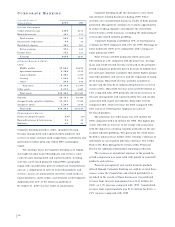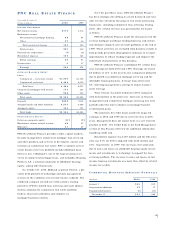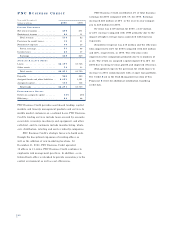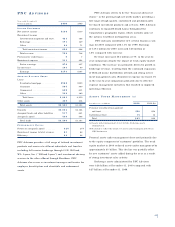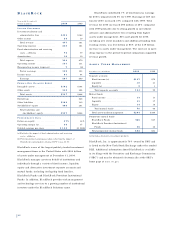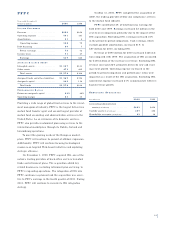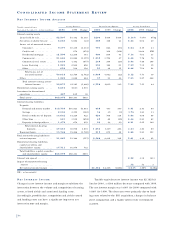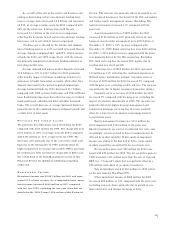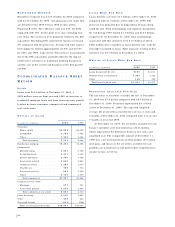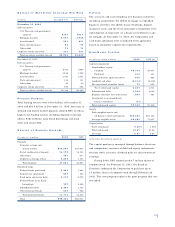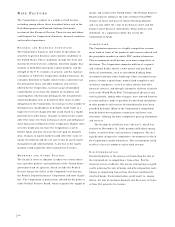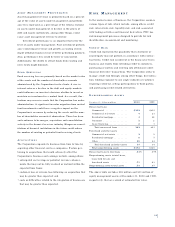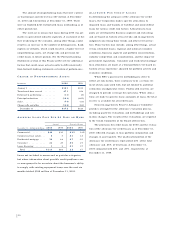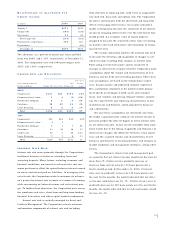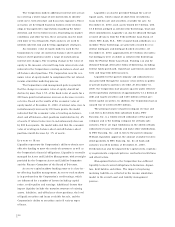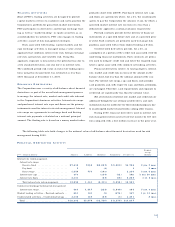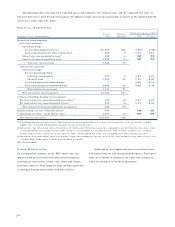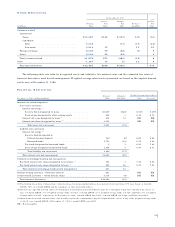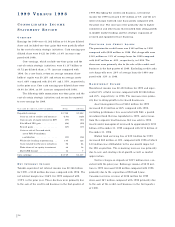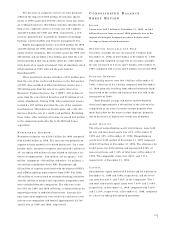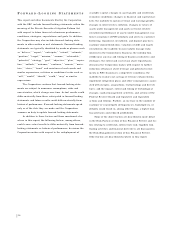PNC Bank 2000 Annual Report Download - page 51
Download and view the complete annual report
Please find page 51 of the 2000 PNC Bank annual report below. You can navigate through the pages in the report by either clicking on the pages listed below, or by using the keyword search tool below to find specific information within the annual report.
48
RI S K FA C T O R S
The Corporation is subject to a number of risk factors,
including among others, those described below and in the
Risk Management and Forward-Looking Statements
sections of this Financial Review. These factors and others
could impact the Corporation’s business, financial condition
and results of operations.
BU S I N E S S A N D EC O N O M I C CO N D I T I O N S
The Corporation's business and results of operations are
sensitive to general business and economic conditions in
the United States. These conditions include the level and
movement of interest rates, inflation, monetary supply, fluc -
tuations in both debt and equity capital markets, and the
strength of the U.S. economy, in general, and the regional
economies in which the Corporation conducts business. An
economic downturn or higher interest rates could decrease
the demand for loans and other products and services
offered by the Corporation, increase usage of unfunded
commitments or increase the number of customers and
counterparties who become delinquent, file for protection
under bankruptcy laws or default on their loans or other
obligations to the Corporation. An increase in the number of
delinquencies, bankruptcies or defaults could result in a
higher level of net charge-offs that could result in a higher
provision for credit losses. Changes in interest rates could
affect the value of certain on-balance-sheet and off-balance-
sheet financial instruments of the Corporation. Higher inter-
est rates would also increase the Corporation's cost to
borrow funds and may increase the rate paid on deposits.
Also, changes in equity markets could affect the value of
equity investments and the net asset value of assets under
management and administration. A decline in the equity
markets could negatively affect noninterest revenues.
MO N E TA R Y A N D OT H E R PO L I C I E S
The financial services industry is subject to various mone-
tary and other policies and regulations of the United States
government and its agencies, which include the Federal
Reserve Board, the Office of the Comptroller of Currency,
the Federal Deposit Insurance Corporation and state regula-
tors. The Corporation is particularly affected by the policies
of the Federal Reserve Board, which regulates the supply of
money and credit in the United States. The Federal Reserve
Board’s policies influence the rates of interest that PNC
charges on loans and pays on interest-bearing deposits
and can also affect the value of on-balance-sheet and off-
balance-sheet financial instruments. Those policies also
determine, to a significant extent, the cost to the
Corporation of funds.
CO M P E T I T I O N
The Corporation operates in a highly competitive environ-
ment, both in terms of the products and services offered and
the geographic markets in which PNC conducts business.
This environment could become even more competitive in
the future. The Corporation competes with local, regional
and national banks, thrifts, credit unions and non-bank
financial institutions, such as investment banking firms,
investment advisory firms, brokerage firms, investment com-
panies, venture capital firms, mutual fund complexes and
insurance companies, as well as other entities that offer
financial services, and through alternative delivery channels
such as the World Wide Web. Technological advances and
new legislation, among other changes, have lowered barriers
to entry and have made it possible for non-bank institutions
to offer products and services that traditionally have been
provided by banks. Many of the Corporation’s competitors
benefit from fewer regulatory constraints and lower cost
structures, allowing for more competitive pricing of products
and services.
The Gramm-Leach-Bliley Act (“the Act”), which was
enacted on November 12, 1999, permits affiliations among
banks, securities firms and insurance companies. The Act
significantly changes the competitive environment in which
the Corporation conducts business. This environment could
result in a loss of customers and related revenue.
DI S I N T E R M E D I AT I O N
Disintermediation is the process of eliminating the role of
the intermediary in completing a transaction. For the
financial services industry, this means eliminating or signifi-
cantly reducing the role of banks and other depository insti-
tutions in completing transactions that have traditionally
involved banks. Disintermediation could result in, among
others, the loss of customer deposits and decreases in trans-
actions that generate fee income.


